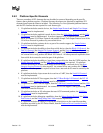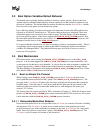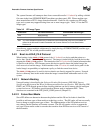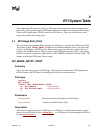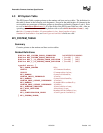
Boot Manager
Version 1.10 12/01/02 3-7
3.3 Boot Option Variables Default Behavior
The default state of globally-defined variables is firmware vendor specific. However the boot
options require a standard default behavior in the exceptional case that valid boot options are not
present on a platform. The default behavior must be invoked any time the BootOrder variable
does not exist or only points to nonexistent boot options.
If no valid boot options exist, the boot manager will enumerate all removable EFI media devices
followed by all fixed EFI media devices. The order within each group is undefined. These new
default boot options are not saved to non volatile storage. The boot manger will then attempt to
boot from each boot option. If the device supports the SIMPLE_FILE_SYSTEM
protocol then
the removable media boot behavior (see section 3.4.1.1) is executed. Otherwise the firmware will
attempt to boot the device via the LOAD_FILE
protocol .
It is expected that this default boot will load an operating system or a maintenance utility. If this is
an operating system setup program it is then responsible for setting the requisite environment
variables for subsequent boots. The platform firmware may also decide to recover or set to a
known set of boot options.
3.4 Boot Mechanisms
EFI can boot from a device using the SIMPLE_FILE_SYSTEM protocol or the LOAD_FILE
protocol. A device that supports the SIMPLE_FILE_SYSTEM protocol must materialize a file
system protocol for that device to be bootable. If a device does not wish to support a complete file
system it may produce a LOAD_FILE protocol which allows it to materialize an image directly.
The Boot Manager will attempt to boot using the SIMPLE_FILE_SYSTEM protocol first. If that
fails, then the LOAD_FILE protocol will be used.
3.4.1 Boot via Simple File Protocol
When booting via the SIMPLE_FILE_SYSTEM protocol, the FilePath will start with a
device path that points to the device that “speaks” the SIMPLE_FILE_SYSTEM protocol. The
next part of the FilePath will point to the file name, including sub directories that contain the
bootable image. If the file name is a null device path, the file name must be discovered on the
media using the rules defined for removable media devices with ambiguous file names (see
section 3.4.1.1 below).
The format of the file system specified by EFI is contained in Chapter 11. While the firmware must
produce a SIMPLE_FILE_SYSTEM protocol that understands the EFI file system, any file system
can be abstracted with the SIMPLE_FILE_SYSTEM protocol interface.
3.4.1.1 Removable Media Boot Behavior
On a removable media device it is not possible for the FilePath to contain a file name, including
sub directories. The FilePath is stored in non volatile memory in the platform and cannot
possibly be kept in sync with a media that can change at any time. A FilePath for a removable
media device will point to a device that “speaks” the SIMPLE_FILE_SYSTEM protocol. The
FilePath will not contain a file name or sub directories.



